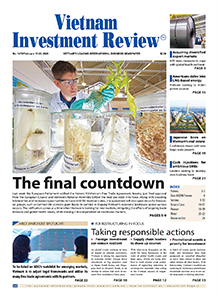Vietnam still primary investing beneficiary
As a result, I believe investment in Vietnam will continue to grow in 2025 and 2026, despite current global uncertainties. This expectation is driven by three key factors.
 |
| Matthew Lourey, chairman, Alitium |
Firstly, investments in manufacturing, real estate, and infrastructure (among others) are inherently long-term, with decision-making and approval processes spanning significant periods. Given that these investments are made with a long-term outlook, short-term disruptions or concerns are unlikely to have a material impact on decisions regarding Vietnam.
Secondly, China’s growing geopolitical complexities continue to drive manufacturers to seek alternative locations. Even amid a slowing global investment landscape, Vietnam remains a primary beneficiary of this ongoing shift in global manufacturing and investment away from China.
Thirdly, the United States remains Vietnam’s largest export destination, and many investors are drawn to Vietnam due to its strong economic ties with the US in recent years. However, Vietnam has strategically ensured that it is not overly reliant on a single market. Through the significant number of free trade agreements entered into in recent years, Vietnam has positioned itself as a globally integrated export and investment hub, reducing its dependency on any one trading partner.
That said, Vietnam will need to navigate potential challenges arising from the US administration’s trade agenda, particularly if policies targeting trade imbalances result in short-term difficulties for countries with a strong surplus with the US. However, as US companies face broad tariff measures across multiple markets, it is unlikely that Vietnam alone will be singled out.
Additionally, US businesses manufacture for global markets, not just domestic consumption. While a slowdown in US domestic demand or global trade could impact international investment flows, Vietnam’s foreign direct investment is unlikely to see immediate effects, particularly given that investors have likely factored potential trade constraints into their long-term planning.
Regarding the Vietnamese government’s recent initiative to encourage high-tech investment through an investment support fund - where certain semiconductor and AI manufacturing projects can receive up to half of their investment costs - this policy will have a significant impact. In 2024, Vietnam missed out on several high-tech investment opportunities, with global technology companies opting for other locations, partly due to the limited incentives previously available.
With this new fund and proactive government outreach, Vietnam is now better positioned to attract the next wave of high-tech investment in the coming years - though it is important to recognise the long lead times required for such projects to reach production.
It is crucial for Vietnam to continue shifting away from a reliance on low-value, labour-intensive manufacturing and towards higher value-added industries. The country’s demographic trends highlight the need for this transition over the next decade, not forgetting that this transition has already been occurring for some years now. While Vietnam has long benefited from a young and accessible workforce, its population is ageing, and the steady rise in wages has gradually eroded its outright competitive advantage in low-cost manufacturing.
As the availability of factory labour declines over time, Vietnam must ensure that its workforce is equipped with the skills necessary to support more advanced industries. Therefore, the government’s focus on attracting high-tech investment is a necessary step in this transition, supporting Vietnam’s long-term goal of moving up the global value chain.
Ultimately, Vietnam’s ability to sustain its momentum in attracting overseas funding will depend on its continued commitment to reform, infrastructure development, and workforce upskilling. While external factors such as global trade tensions, US policy shifts and changes to global supply chains will influence investment decisions, Vietnam’s proactive approach - through further alignment with strategic free trade, targeted investment incentives, and industrial policies - positions it well for long-term success.
If the government can effectively execute its vision of transitioning to a technology focused higher-value economy while maintaining macroeconomic stability, Vietnam will remain one of the most attractive destinations for international investors in the coming years.
 | Foreign investment expansion bodes well for country Vietnam continues to accelerate its efforts to become a premier destination for venture capital and private equity investment. VIR’s Bich Ngoc spoke with Kristine Lauria, director of Operations at Vietnam Private Capital Agency, about the issue. |
 | Public investment may contribute 1 per cent to GDP growth A 40 per cent increase in public investment could add 1 per cent to GDP growth in 2025; however, implementation may be difficult due to remaining bottlenecks. |
What the stars mean:
★ Poor ★ ★ Promising ★★★ Good ★★★★ Very good ★★★★★ Exceptional
Related Contents
Latest News
More News
- Thai Huong: a visionary business leader bridging Vietnam and Russia (November 05, 2025 | 17:00)
- Vietnam poised to play bigger role in global trade, says Citi (October 28, 2025 | 11:07)
- DKSH’s blueprint for sustainable supply chain resilience amid climate change (October 28, 2025 | 11:02)
- Australia contributing to Vietnam’s digital ambitions (October 20, 2025 | 11:04)
- Mizuiku: Vietnam’s model of water conservation inspiring global expansion (October 10, 2025 | 12:50)
- AgriS chairlady named among Fortune’s 100 Most Powerful Women in Asia (October 10, 2025 | 11:13)
- Copenhagen Infrastructure Partners backs Vietnam’s offshore wind ambitions (October 08, 2025 | 18:18)
- GE HealthCare backs Vietnam’s drive for digital transformation in hospitals (October 06, 2025 | 12:06)
- Innovation and digital transformation – the second innovative era for Vietnam (October 06, 2025 | 10:40)
- Citi connects Vietnam’s growth to global opportunity (September 30, 2025 | 15:41)

 Tag:
Tag:





















 Mobile Version
Mobile Version